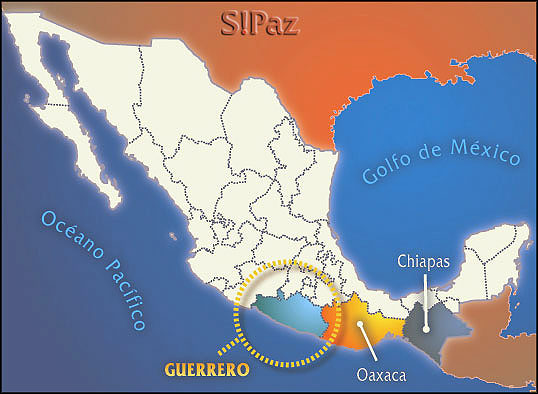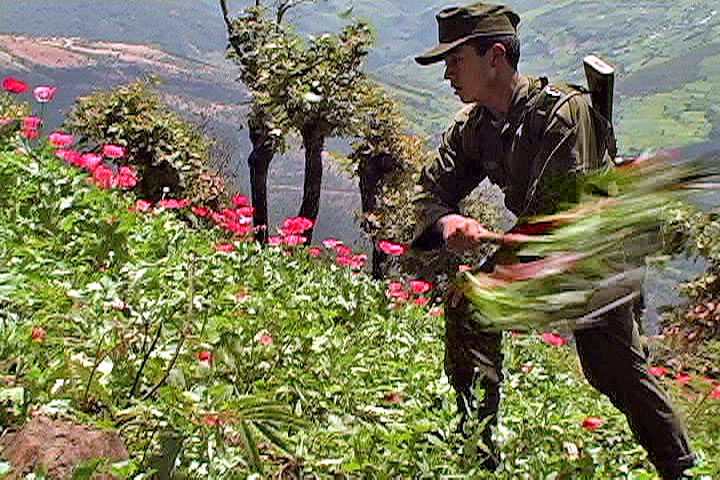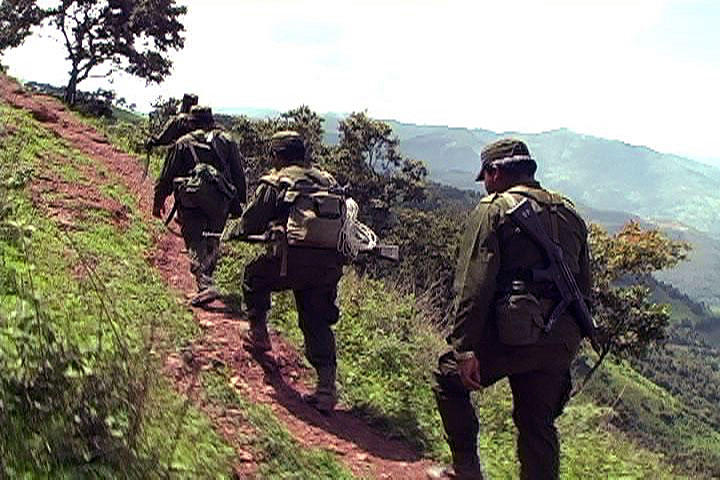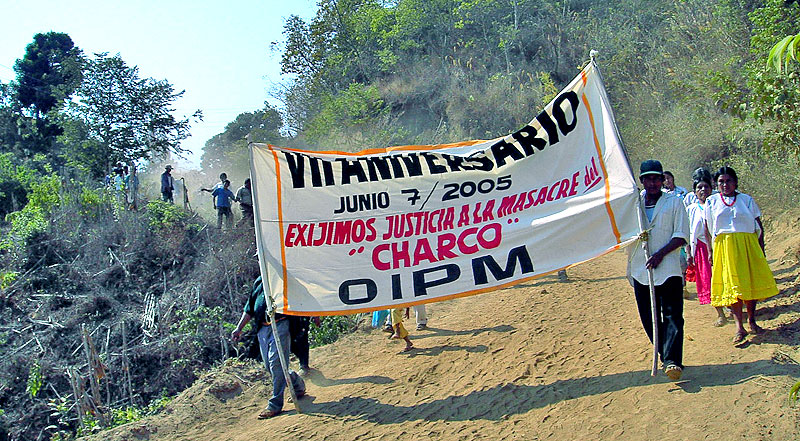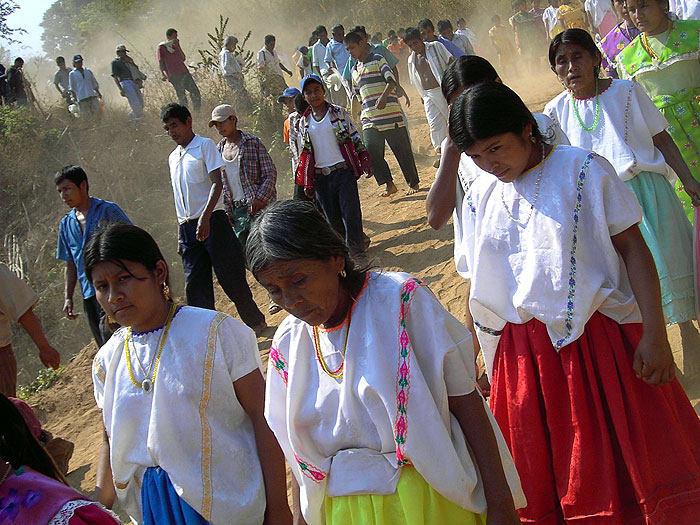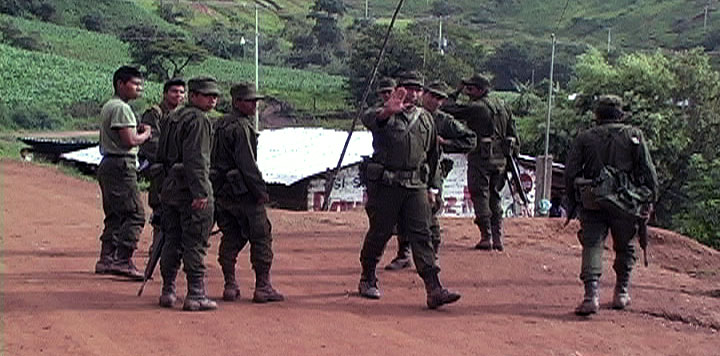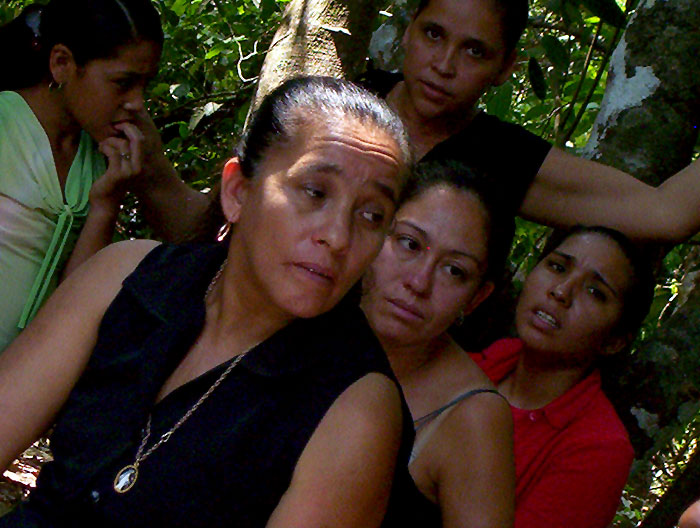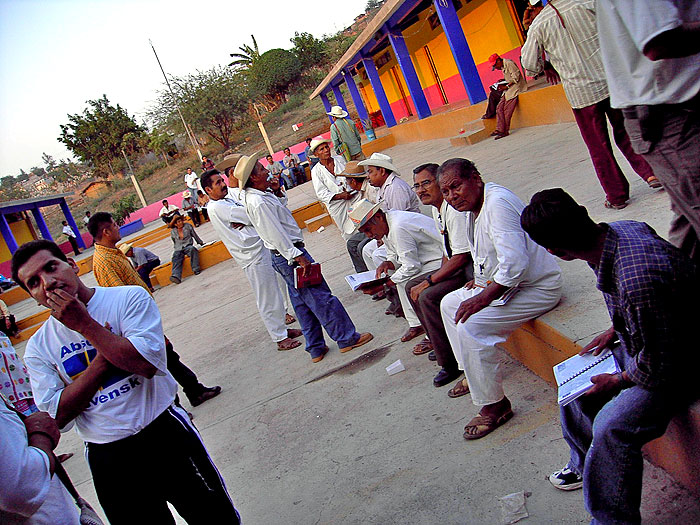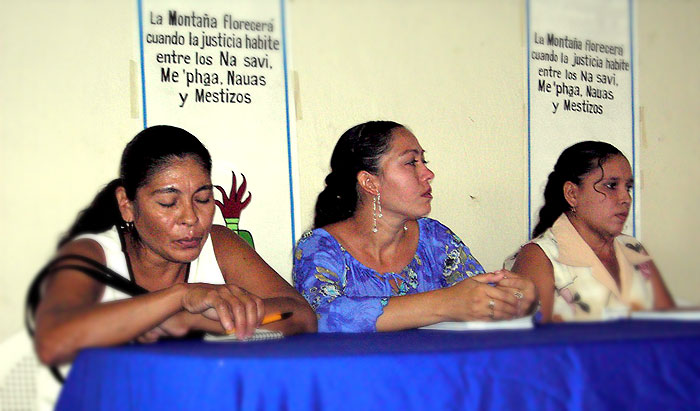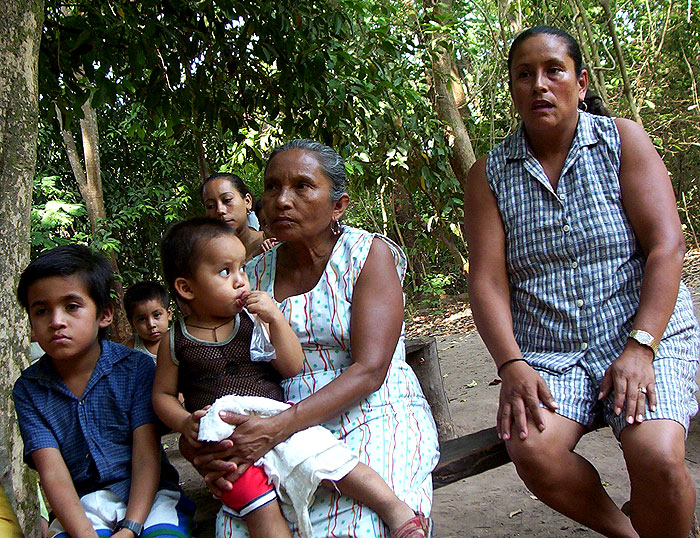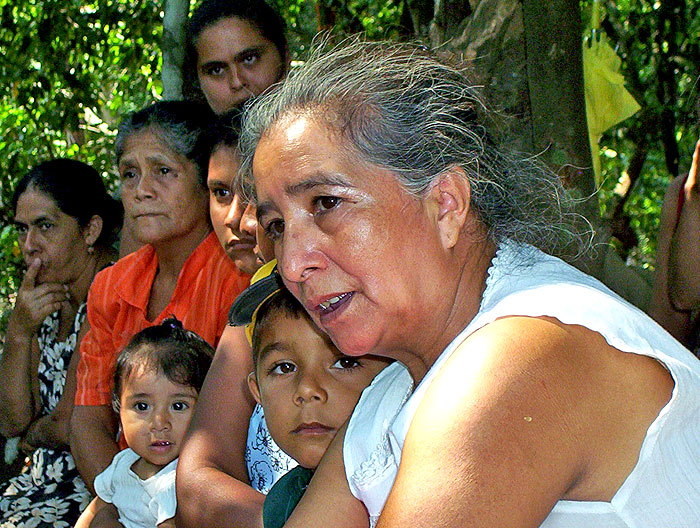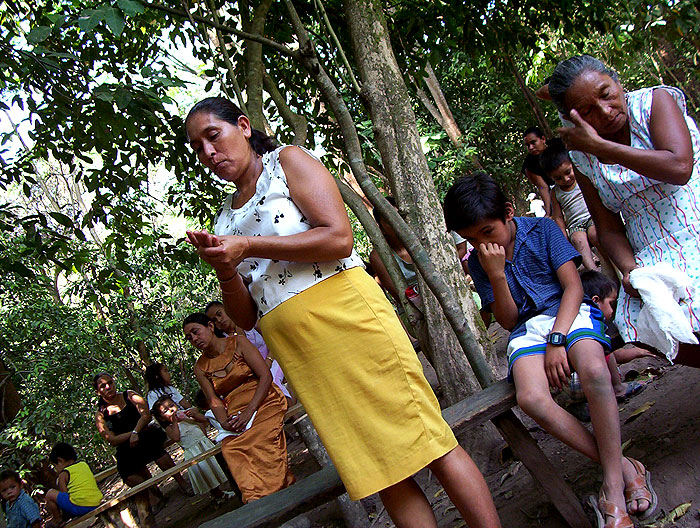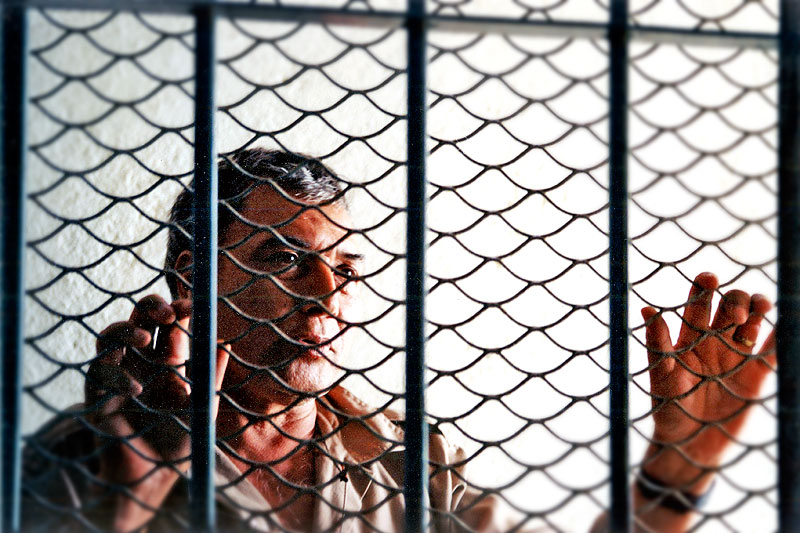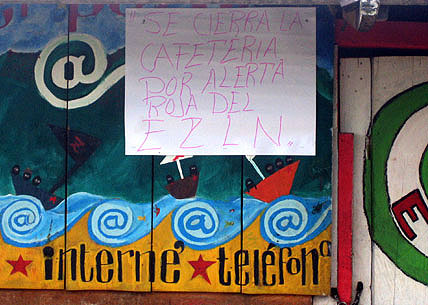SIPAZ Activities (January – March 2005)
31/03/2005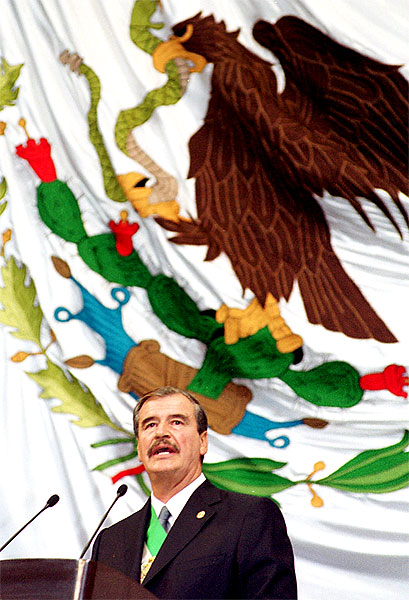
ANALYSIS: Mexico, Between Electoral Pre-campaigns and the “Other Campaign” of the Zapatistas
31/10/2005Too many Guerrerenses die on their feet.
Too many indignant dead in a state where
death by blade, sword or bullet is a natural death.
If it is true that the murdered don’t rest,
Guerrero is an immense congregation of the waking dead.
Armando Bartra. Deep South
Guerrero, Oaxaca y Chiapas: A Triangle of Poverty
It has been noted that the national and international attention on Chiapas and its armed conflict succeeded in decreasing the direct violence and in generating pressure on the state and federal governments because of the political cost of repression and its deaths. But while this concern has been focused on Chiapas, in other states, such as Oaxaca and Guerrero, social, campesino and indigenous organizations have continued to suffer threats, violence and militarization without many voices denouncing these crimes and thus leaving open a door for impunity.
In these other Mexican states, the same structural causes which provoked the uprising of the Zapatista Army of National Liberation (EZLN) in Chiapas are also present: the lack of basic social and economic rights such as housing, education and health care along with the discrimination and racism cultivated during centuries of internal and external colonialism.
The state of Guerrero, together with Chiapas and Oaxaca, form a triangle of extreme poverty according to socioeconomic indicators for the year 2000 provided by the National Population Council (CONAPO). A third of the indigenous peoples of Mexico are concentrated in these states. The ‘indigenous population in the municipalities of Guerrero is still marginalized 95.9% of the population of Guerrero does not have access to services (Socioeconomic indicators of the indigenous peoples of Mexico-National Indigenous Institute, 2002). As for the right to education, approximately half of the population has not attended school.
Struggle and Resistance in Guerrero: Yesterday and Today
In the 60’s and 70’s, Guerrero was home to the armed revolutionary movements of Genaro Vázquez and Lucio Cabañas. Both rose up in response to the poverty and social injustice lived in Guerrero and in opposition to the corrupt and clientelistic political system of the Institutional Revolutionary Party – PRI. The partnership between the caciques, or local political bosses, and the PRI created closed circles of power that opposed the armed groups (see ‘Ideario del Partido de los Pobres’, Sierra del estado de Guerrero, March 1973).
The government employed its security forces to respond to the guerillas, persecuting not only the leaders and their guerilla cells, but also all those who could have been a civilian base for any armed group. This included the great majority of campesino and indigenous populations, especially those who had become organized to improve their living conditions.
Arbitrary detentions, forced disappearances, torture and assassinations filled the pages of this period in Mexico’s history known as ‘The Dirty War.’ Currently, organizations like the Association of Families of the Detained, Disappeared and Victims of Human Rights Abuses in Mexico (AFADEM) continue to demand full disclosure about these crimes and refuse to allow the deaths to be forgotten. The association has documented more than 400 cases of disappeared people in the state of Guerrero during ‘The Dirty War.’
Due to Guerrero’s history of struggle and resistance, the armed insurrection of 1994 in Chiapas caused the government to fear the start of a similar rebellion in this state. This meant a rise in the militarization of Guerrero not seen since the times of Lucio Cabañas as well as the harrassment of leaders and members of peasant and indigenous organizations.
The massacres of Aguas Blancas on June 28th, 1995, and in El Charco on June 7th, 1998, are two examples of the State’s repression of peasant and indigenous organizations, within the rationale of the ‘struggle against armed clandestine groups’. In Aguas Blancas, 17 members of the Campesino Organization of the Sierra of the South (OCSS) were intercepted and assassinated by members of the Mexican Army when they were heading to a demonstration. During the first anniversary of the massacre of Aguas Blancas in 1996, the guerilla group, Popular Revolutionary Army (EPR), publicly appeared, calling for a change of the ‘exploitative and oppressive’ government (see, ‘El Sur’, June 28, 2005). In their Manifesto of Aguas Blancas (1996), they made a call to arms against institutional violence and encouraged the creation of armed self-defense groups and popular tribunals to judge those who repress the people.
During the early morning of June 7th, 1998, in the community of El Charco, the Mexican Army surrounded the school where representatives of different communities were sleeping. They were resting after a coordinating meeting of nearby towns, called together by the Independent Organization of the Mixtecos and Tlapanecos Peoples. In this assembly, there were also some ‘outsiders‘ present, such as Efrén Cortés who had presented a project for rural development, and Ericka Zamora and Ricardo Zavala who brought a proposal for a literacy program for the communities. Once the meeting had ended, three people arrived at the gathering, identified themselves as members of a guerilla group wanting to know the opinion of the communities.
Some people returned to their communities, but those who were not from the area and other representatives decided to stay the night. At dawn, the Mexican Army massacred 11 people (among them Ricardo Zavala), 5 others were injured and 21 were detained, including Ericka Zamora and Efrén Cortés, who were accused of being commanders of the EPR. They were tortured and charged with rebellion, conspiracy, inciting rebellion and weapons possession. Efrén was sentenced to six years and six months in prison and Ericka to eight. Both were taken to the maximum-security prison, Puente Grande, in the state of Jalisco. The rest of the detainees received lesser sentences of one or two years.
Ex-political prisoners and members of OCSS and other organizations came to the most recent commemoration of the anniversary of the massacre at El Charco. The majority of these people had experienced years of torture while imprisoned in Puente Grande with Efrén and Ericka. They shared with us about the nights of harassment in which they were unable to sleep and the so-called “reeducation” to which they were subjected, obligating them to begin primary school again “to crush our dignity” (testimony of an ex-political prisoner).
History shows that counter-insurgency has not halted the creation of new guerilla groups. Recently, the “Popular Revolutionary Command – the Patria is First” appeared, announcing the judgment and sentencing of those responsible for the massacre of Aguas Blancas, executing one of them (La Jornada, July 9th, 2005).
The Department of Defense justifies militarization as a necessary part of the war against narco-trafficking and arms smuggling. Guerrero is the main producer of poppies (raw material for opium production). Campesino and indigenous communities are held responsible for the cultivation of poppies, but the ‘anti drug’ policies don’t seek to resolve the true root causes of the problem. Extreme poverty and the fall in the prices of agricultural products have caused campesinos to see the growing of opiates as a “way out.”
International organizations have recommended to the Mexican Army that it separate itself from this type of work, which covers up grave human rights abuses. In this sense, the UN special rapporteur on summary, arbitrary, and extra judicial executions asked the Mexican State to “achieve the demilitarization of society and avoid delegating to the armed forces the maintenance of public order or the fight against crime… Begin the necessary reforms so that regular courts can judge all those accused of human rights abuses, whatever their profession.” (25/11799).
From 1996 to 2004, the Tlachinollan Center for Human Rights has documented 68 cases of human rights violations by the army (including rape and summary executions). To date, all remain unsolved.
From the Voice of the Water to the Defense of the Forests
The resistance of indigenous people and campesinos in Guerrero has not been solely an armed one. Campesino and indigenous organizations have worked daily to defend their rights and to construct new social alternatives grounded in their own knowledge and values, such as community, solidarity, mutual respect, simplicity, ritual, the power of service, dialogue and reconciliation.
At the early ’90s, the Guerreran Council of 500 years of Indigenous, Black and Popular Resistance (CG500ARINP) was formed, one of the principal indigenous organizations advocating protest against the 500th anniversary celebrations of the Spanish conquest of the Americas.
11 years ago in the Mountain region, the Tlachinollan Mountain Center for Human Rights was formed with the goal of making human rights effectual, from a holistic perspective, in which economic, social and political rights are inherent to civil and political rights. With the State Forum ‘Our Word Made Path’ held on June 3rd and 4th of this year, the Center not only celebrated its 11th anniversary, but also created a bridge between the different organizations which it supports.
The Tlachinollan staff recognized that in its 11 years of walking together with indigenous peoples, “learning their word, they learned to be defenders of Human Rights.” And it is true that they have learned to leave behind a monocultural vision of justice and human rights: “among the people there exists a teaching of how to bring about justice, discussing, meeting with elders; a justice that speaks tlapaneco, mixteco, a justice that is on the table (…) we have to strip ourselves of the arrogant idea that we are the enlightened ones” (from the opening speech of Abel Barrerea, director of Tlachinollan).
Present in this space of meeting and reflection were the Independent Organization of the Mixteco People (OIPM) and the Organization of the Indigenous People Me’phaa (OPIM), both of the municipality of Ayutla de los Libres, location of the El Charco massacre. These organizations have fought to denounce the militarization of the territory and, specifically, they have defended the cases of two indigenous Me’phaa women, Valentina Rosendo Cantú and Inés Fernández Ortega, who have denounced the torture and sexual violence they suffered at the hands of members of the Mexican army. Obtilia Eugenio Manuel of OPIM has participated as a translator in the judicial process of the rapes of Inés and Valentina and, as a result, has received constant death threats against herself and her family.
At the forum, we learned about efforts to gain the right to housing for a community following a natural disaster which destroyed 266 homes. We also learned about the case of a Nahua community in which 1,600 community members united to reject the Certification Program of Ejido Rights (PROCEDE) due to its impact on their collective vision of land.
The testimonials and experiences of those who are exercising their rights to organize and decide upon their own way of life “from the ground up” were presented.
Radio Ñonmdaa (the word for water in Amuzgo) arose from the autonomous municipality of Xochistlahuaca, as an instrument to strengthen its autonomy. This municipality declared autonomy in 2002 as a response to the corruption existing in the official government’s party. The traditional authorities reinstated their communal form of government and decided not to accept government support. In December of 2004, they created the Ñonmdaa autonomous radio station, through which they communicate their way of understanding life and their traditions. It is the first community radio station in Guerrero and the only one in the Amuzgo language. David Valtierra, representative of the Radio Committee, affirmed that it serves to empower the Amuzgo people and also to create links between isolated communities.
They argue for the right to have their own radio station, citing the San Andrés Accords and the International Labor Organization Convention No. 169 which recognizes the collective rights of indigenous and tribal peoples. Despite this, communications inspectors tried to confiscate the project’s equipment on February 25th. These actions accompany the harassment that the autonomous authorities have suffered since declaring their autonomy. The majority of them have outstanding warrants for their arrest.
Also present were members of the Community Police, created because of the high levels of delinquency in the Mountain Coast region and the corrupt and monocultural judicial system. The communities organized themselves to have their own Community Public Security Department. Not stopping there, they are also creating their own systems of justice and reeducation by reviving their own traditional systems and incorporating positive Mexican law. Next October 15th will mark their 10-year anniversary and, as they say, in this period, they “have advanced much and stumbled much as well.” They created the Regional Coordinator of Community Authorities (CRAC), a community body charged with imparting community justice. Through this group they try to reeducate delinquents because, as they say, “the official jails make one more brutal.” They believe that it is much more beneficial, to both the delinquent and the society, that he be able to reintegrate himself into his community. They don’t speak of punishment, but rather of sanctions, of reconciliation or reparation of damages. Currently, there are outstanding arrest warrants against the community police.
The participation of the peasant women ecologists of the Sierra de Petatlán y Coyuca de Catalán was one of the most moving moments of the forum, because of the repression and harassment that they suffer for defending the forests against excessive clandestine logging. The president of the Organization of Women of the Sierra de Petatlán y Coyuca de Catalán, Celsa Baldovinos, is the wife of Felipe Arreaga, a recognized environmental activist in the region, who is currently in jail, imprisoned unjustly as a reprisal for his environmental work. Felipe Arreaga and Celsa encouraged the women to create this organization to fight pollution and deforestation. Today the group numbers about 60 women from various communities.
Visiting them in the Sierra de Petatlán, we were able to learn about their red cedar reforestation project and how they have managed to stop the fires that had previously ravaged the region. We also learned of their forest and river clean-up campaigns. They involve entire families in their vegetable garden projects, in an effort to recover food self-sufficiency. They have a “savings bank,” through which they loan money at a 5% interest rate to those in need. To those who do not have a savings account, they give loans at a slightly elevated interest rate and the benefits are invested in the organization’s projects.
The anger of these women who live in a climate of constant threats and harassment for “defending the forests” made their voices break when they spoke of the repression suffered by Felipe Arreaga and other campesino ecologists. In the forum they remembered the ambush recently suffered by Albertano Peñaloza, in which two of his children died, leaving him and two more of his children gravely injured. Celsa told us, “How is it possible that every time we advance as an organization, something awful happens? I am worried that it will continue, that they will never let us work.”
The Sierra is a microcosm of the injustice and impunity that govern Guerrero. The bonds between regional caciques, authorities and military officers, with narcotrafficking in the middle, gives an idea of the context in which the campesino ecologists, and the rest of the organizations mentioned, work and struggle.
This article attempts to provide a small window into a reality that is tragic, while at the same time full of hope. It is the people themselves who resist and fight the most adverse situations to bring about an end to unjust policies which would condemn them to disappear. It is true that militarization, continued repression and economic difficulties have destroyed the social fabric and have expelled many people from the communities as migrants. But there also exist many successes, such as those mentioned above, that demonstrate the energy of the communities to reinvent themselves and revive their culture.

